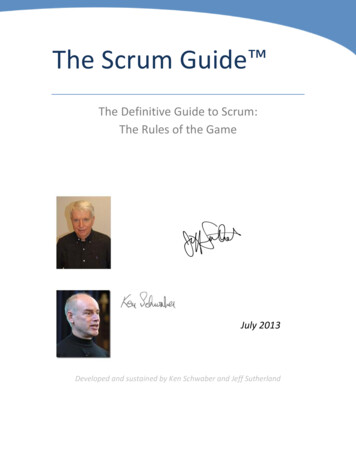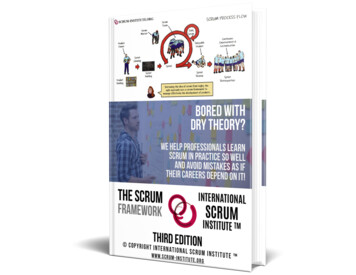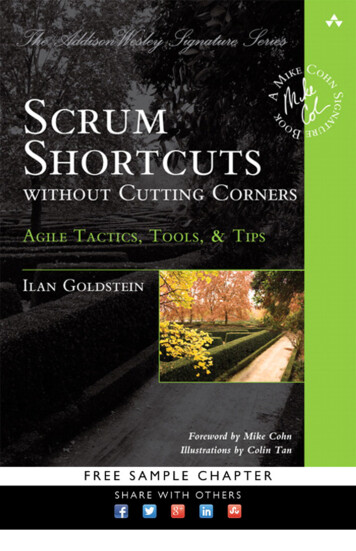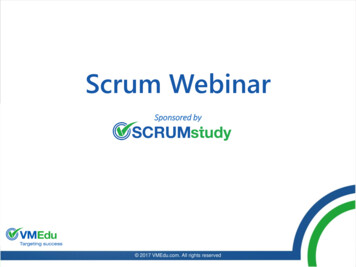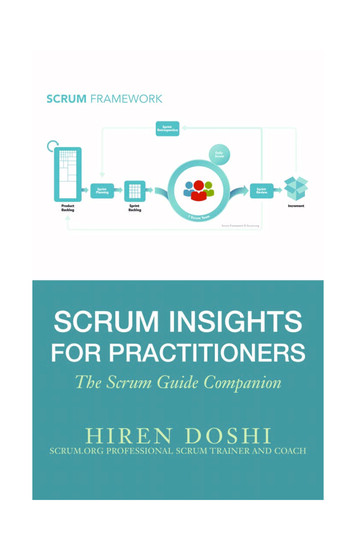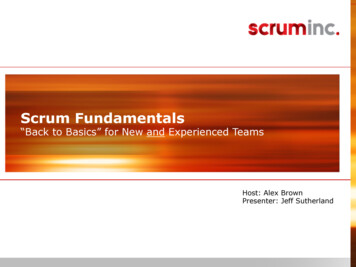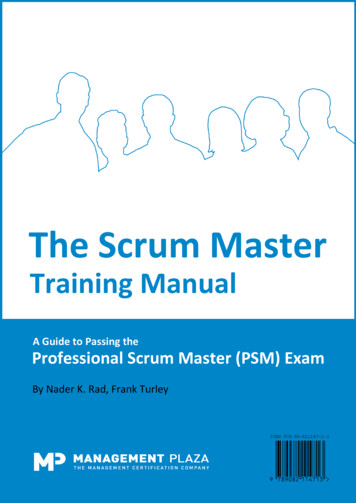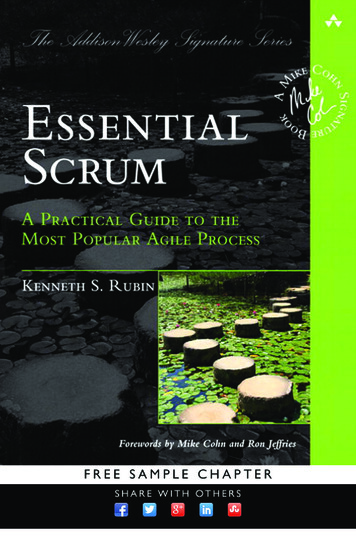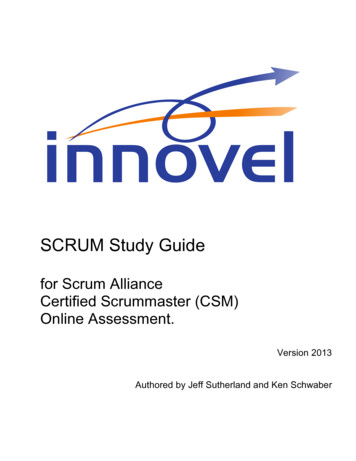
Transcription
innovelSCRUM Study Guidefor Scrum AllianceCertified Scrummaster (CSM)Online Assessment.Version 2013Authored by Jeff Sutherland and Ken Schwaber
Table of ContentsPurpose of the Scrum Guide . 3Definition of Scrum. 3Scrum Theory . 3The Scrum Team . 4The Product Owner . 5The Development Team . 5The Scrum Master . 6Scrum Events . 7The Sprint . 7Sprint Planning . 8Daily Scrum . 10Sprint Review. 11Sprint Retrospective . 12Scrum Artifacts . 12Product Backlog . 12Sprint Backlog . 14Increment . 15Artifact Transparency . 15Definition of “Done” . 15End Note. 16Acknowledgements . 16People . 16History . 16 2014 Scrum.Org and ScrumInc. Offered for license under the Attribution Share-Alike license of Creative Commons,accessible at lcode and also described in summary form athttp://creativecommons.org/licenses/by-sa/4.0/. By utilizing this Scrum Guide you acknowledge and agree that youhave read and agree to be bound by the terms of the Attribution Share-Alike license of Creative Commons.Page 2
Purpose of the Scrum GuideScrum is a framework for developing and sustaining complex products. This Guide contains thedefinition of Scrum. This definition consists of Scrum’s roles, events, artifacts, and the rules thatbind them together. Ken Schwaber and Jeff Sutherland developed Scrum; the Scrum Guide iswritten and provided by them. Together, they stand behind the Scrum Guide.Definition of ScrumScrum (n): A framework within which people can address complex adaptive problems, whileproductively and creatively delivering products of the highest possible value.Scrum is:LightweightSimple to understandDifficult to masterScrum is a process framework that has been used to manage complex product developmentsince the early 1990s. Scrum is not a process or a technique for building products; rather, it is aframework within which you can employ various processes and techniques. Scrum makes clearthe relative efficacy of your product management and development practices so that you canimprove.The Scrum framework consists of Scrum Teams and their associated roles, events, artifacts, andrules. Each component within the framework serves a specific purpose and is essential toScrum’s success and usage.The rules of Scrum bind together the events, roles, and artifacts, governing the relationships andinteraction between them. The rules of Scrum are described throughout the body of thisdocument.Specific tactics for using the Scrum framework vary and are described elsewhere.Scrum TheoryScrum is founded on empirical process control theory, or empiricism. Empiricism asserts thatknowledge comes from experience and making decisions based on what is known. Scrumemploys an iterative, incremental approach to optimize predictability and control risk.Three pillars uphold every implementation of empirical process control: transparency,inspection, and adaptation. 2014 Scrum.Org and ScrumInc. Offered for license under the Attribution Share-Alike license of Creative Commons,accessible at lcode and also described in summary form athttp://creativecommons.org/licenses/by-sa/4.0/. By utilizing this Scrum Guide you acknowledge and agree that youhave read and agree to be bound by the terms of the Attribution Share-Alike license of Creative Commons.Page 3
TransparencySignificant aspects of the process must be visible to those responsible for the outcome.Transparency requires those aspects be defined by a common standard so observers share acommon understanding of what is being seen.For example:A common language referring to the process must be shared by all participants; and,Those performing the work and those accepting the work product must share a commondefinition of “Done”.InspectionScrum users must frequently inspect Scrum artifacts and progress toward a Sprint Goal to detectundesirable variances. Their inspection should not be so frequent that inspection gets in the wayof the work. Inspections are most beneficial when diligently performed by skilled inspectors atthe point of work.AdaptationIf an inspector determines that one or more aspects of a process deviate outside acceptablelimits, and that the resulting product will be unacceptable, the process or the material beingprocessed must be adjusted. An adjustment must be made as soon as possible to minimizefurther deviation.Scrum prescribes four formal events for inspection and adaptation, as described in the ScrumEvents section of this document:Sprint PlanningDaily ScrumSprint ReviewSprint RetrospectiveThe Scrum TeamThe Scrum Team consists of a Product Owner, the Development Team, and a Scrum Master.Scrum Teams are self-organizing and cross-functional. Self-organizing teams choose how best toaccomplish their work, rather than being directed by others outside the team. Cross-functionalteams have all competencies needed to accomplish the work without depending on others notpart of the team. The team model in Scrum is designed to optimize flexibility, creativity, andproductivity.Scrum Teams deliver products iteratively and incrementally, maximizing opportunities forfeedback. Incremental deliveries of “Done” product ensure a potentially useful version ofworking product is always available. 2014 Scrum.Org and ScrumInc. Offered for license under the Attribution Share-Alike license of Creative Commons,accessible at lcode and also described in summary form athttp://creativecommons.org/licenses/by-sa/4.0/. By utilizing this Scrum Guide you acknowledge and agree that youhave read and agree to be bound by the terms of the Attribution Share-Alike license of Creative Commons.Page 4
The Product OwnerThe Product Owner is responsible for maximizing the value of the product and the work of theDevelopment Team. How this is done may vary widely across organizations, Scrum Teams, andindividuals.The Product Owner is the sole person responsible for managing the Product Backlog. ProductBacklog management includes:Clearly expressing Product Backlog items;Ordering the items in the Product Backlog to best achieve goals and missions;Optimizing the value of the work the Development Team performs;Ensuring that the Product Backlog is visible, transparent, and clear to all, and shows whatthe Scrum Team will work on next; and,Ensuring the Development Team understands items in the Product Backlog to the levelneeded.The Product Owner may do the above work, or have the Development Team do it. However, theProduct Owner remains accountable.The Product Owner is one person, not a committee. The Product Owner may represent thedesires of a committee in the Product Backlog, but those wanting to change a Product Backlogitem’s priority must address the Product Owner.For the Product Owner to succeed, the entire organization must respect his or her decisions. TheProduct Owner’s decisions are visible in the content and ordering of the Product Backlog. Noone is allowed to tell the Development Team to work from a different set of requirements, andthe Development Team isn’t allowed to act on what anyone else says.The Development TeamThe Development Team consists of professionals who do the work of delivering a potentiallyreleasable Increment of “Done” product at the end of each Sprint. Only members of theDevelopment Team create the Increment.Development Teams are structured and empowered by the organization to organize andmanage their own work. The resulting synergy optimizes the Development Team’s overallefficiency and effectiveness.Development Teams have the following characteristics:They are self-organizing. No one (not even the Scrum Master) tells the Development Teamhow to turn Product Backlog into Increments of potentially releasable functionality;Development Teams are cross-functional, with all of the skills as a team necessary to createa product Increment; 2014 Scrum.Org and ScrumInc. Offered for license under the Attribution Share-Alike license of Creative Commons,accessible at lcode and also described in summary form athttp://creativecommons.org/licenses/by-sa/4.0/. By utilizing this Scrum Guide you acknowledge and agree that youhave read and agree to be bound by the terms of the Attribution Share-Alike license of Creative Commons.Page 5
Scrum recognizes no titles for Development Team members other than Developer,regardless of the work being performed by the person; there are no exceptions to this rule;Scrum recognizes no sub-teams in the Development Team, regardless of particular domainsthat need to be addressed like testing or business analysis; there are no exceptions to thisrule; and,Individual Development Team members may have specialized skills and areas of focus, butaccountability belongs to the Development Team as a whole.Development Team SizeOptimal Development Team size is small enough to remain nimble and large enough tocomplete significant work within a Sprint. Fewer than three Development Team membersdecrease interaction and results in smaller productivity gains. Smaller Development Teams mayencounter skill constraints during the Sprint, causing the Development Team to be unable todeliver a potentially releasable Increment. Having more than nine members requires too muchcoordination. Large Development Teams generate too much complexity for an empirical processto manage. The Product Owner and Scrum Master roles are not included in this count unlessthey are also executing the work of the Sprint Backlog.The Scrum MasterThe Scrum Master is responsible for ensuring Scrum is understood and enacted. Scrum Mastersdo this by ensuring that the Scrum Team adheres to Scrum theory, practices, and rules.The Scrum Master is a servant-leader for the Scrum Team. The Scrum Master helps thoseoutside the Scrum Team understand which of their interactions with the Scrum Team are helpfuland which aren’t. The Scrum Master helps everyone change these interactions to maximize thevalue created by the Scrum Team.Scrum Master Service to the Product OwnerThe Scrum Master serves the Product Owner in several ways, including:Finding techniques for effective Product Backlog management;Helping the Scrum Team understand the need for clear and concise Product Backlog items;Understanding product planning in an empirical environment;Ensuring the Product Owner knows how to arrange the Product Backlog to maximize value;Understanding and practicing agility; and,Facilitating Scrum events as requested or needed.Scrum Master Service to the Development TeamThe Scrum Master serves the Development Team in several ways, including:Coaching the Development Team in self-organization and cross-functionality;Helping the Development Team to create high-value products;Removing impediments to the Development Team’s progress; 2014 Scrum.Org and ScrumInc. Offered for license under the Attribution Share-Alike license of Creative Commons,accessible at lcode and also described in summary form athttp://creativecommons.org/licenses/by-sa/4.0/. By utilizing this Scrum Guide you acknowledge and agree that youhave read and agree to be bound by the terms of the Attribution Share-Alike license of Creative Commons.Page 6
Facilitating Scrum events as requested or needed; and,Coaching the Development Team in organizational environments in which Scrum is not yetfully adopted and understood.Scrum Master Service to the OrganizationThe Scrum Master serves the organization in several ways, including:Leading and coaching the organization in its Scrum adoption;Planning Scrum implementations within the organization;Helping employees and stakeholders understand and enact Scrum and empirical productdevelopment;Causing change that increases the productivity of the Scrum Team; and,Working with other Scrum Masters to increase the effectiveness of the application of Scrumin the organization.Scrum EventsPrescribed events are used in Scrum to create regularity and to minimize the need for meetingsnot defined in Scrum. All events are time-boxed events, such that every event has a maximumduration. Once a Sprint begins, its duration is fixed and cannot be shortened or lengthened. Theremaining events may end whenever the purpose of the event is achieved, ensuring anappropriate amount of time is spent without allowing waste in the process.Other than the Sprint itself, which is a container for all other events, each event in Scrum is aformal opportunity to inspect and adapt something. These events are specifically designed toenable critical transparency and inspection. Failure to include any of these events results inreduced transparency and is a lost opportunity to inspect and adapt.The SprintThe heart of Scrum is a Sprint, a time-box of one month or less during which a “Done”, useable,and potentially releasable product Increment is created. Sprints best have consistent durationsthroughout a development effort. A new Sprint starts immediately after the conclusion of theprevious Sprint.Sprints contain and consist of the Sprint Planning, Daily Scrums, the development work, theSprint Review, and the Sprint Retrospective.During the Sprint:No changes are made that would endanger the Sprint Goal;Quality goals do not decrease; and,Scope may be clarified and re-negotiated between the Product Owner and DevelopmentTeam as more is learned. 2014 Scrum.Org and ScrumInc. Offered for license under the Attribution Share-Alike license of Creative Commons,accessible at lcode and also described in summary form athttp://creativecommons.org/licenses/by-sa/4.0/. By utilizing this Scrum Guide you acknowledge and agree that youhave read and agree to be bound by the terms of the Attribution Share-Alike license of Creative Commons.Page 7
Each Sprint may be considered a project with no more than a one-month horizon. Like projects,Sprints are used to accomplish something. Each Sprint has a definition of what is to be built, adesign and flexible plan that will guide building it, the work, and the resultant product.Sprints are limited to one calendar month. When a Sprint’s horizon is too long the definition ofwhat is being built may change, complexity may rise, and risk may increase. Sprints enablepredictability by ensuring inspection and adaptation of progress toward a Sprint Goal at leastevery calendar month. Sprints also limit risk to one calendar month of cost.Cancelling a SprintA Sprint can be cancelled before the Sprint time-box is over. Only the Product Owner has theauthority to cancel the Sprint, although he or she may do so under influence from thestakeholders, the Development Team, or the Scrum Master.A Sprint would be cancelled if the Sprint Goal becomes obsolete. This might occur if thecompany changes direction or if market or technology conditions change. In general, a Sprintshould be cancelled if it no longer makes sense given the circumstances. But, due to the shortduration of Sprints, cancellation rarely makes sense.When a Sprint is cancelled, any completed and “Done” Product Backlog items are reviewed. Ifpart of the work is potentially releasable, the Product Owner typically accepts it. All incompleteProduct Backlog Items are re-estimated and put back on the Product Backlog. The work done onthem depreciates quickly and must be frequently re-estimated.Sprint cancellations consume resources, since everyone has to regroup in another SprintPlanning to start another Sprint. Sprint cancellations are often traumatic to the Scrum Team,and are very uncommon.Sprint PlanningThe work to be performed in the Sprint is planned at the Sprint Planning. This plan is created bythe collaborative work of the entire Scrum Team.Sprint Planning is time-boxed to a maximum of eight hours for a one-month Sprint. For shorterSprints, the event is usually shorter. The Scrum Master ensures that the event takes place andthat attendants understand its purpose. The Scrum Master teaches the Scrum Team to keep itwithin the time-box.Sprint Planning answers the following:What can be delivered in the Increment resulting from the upcoming Sprint?How will the work needed to deliver the Increment be achieved? 2014 Scrum.Org and ScrumInc. Offered for license under the Attribution Share-Alike license of Creative Commons,accessible at lcode and also described in summary form athttp://creativecommons.org/licenses/by-sa/4.0/. By utilizing this Scrum Guide you acknowledge and agree that youhave read and agree to be bound by the terms of the Attribution Share-Alike license of Creative Commons.Page 8
Topic One: What can be done this Sprint?The Development Team works to forecast the functionality that will be developed during theSprint. The Product Owner discusses the objective that the Sprint should achieve and theProduct Backlog items that, if completed in the Sprint, would achieve the Sprint Goal. The entireScrum Team collaborates on understanding the work of the Sprint.The input to this meeting is the Product Backlog, the latest product Increment, projectedcapacity of the Development Team during the Sprint, and past performance of the DevelopmentTeam. The number of items selected from the Product Backlog for the Sprint is solely up to theDevelopment Team. Only the Development Team can assess what it can accomplish over theupcoming Sprint.After the Development Team forecasts the Product Backlog items it will deliver in the Sprint, theScrum Team crafts a Sprint Goal. The Sprint Goal is an objective that will be met within theSprint through the implementation of the Product Backlog, and it provides guidance to theDevelopment Team on why it is building the Increment.Topic Two: How will the chosen work get done?Having set the Sprint Goal and selected the Product Backlog items for the Sprint, theDevelopment Team decides how it will build this functionality into a “Done” product Incrementduring the Sprint. The Product Backlog items selected for this Sprint plus the plan for deliveringthem is called the Sprint Backlog.The Development Team usually starts by designing the system and the work needed to convertthe Product Backlog into a working product Increment. Work may be of varying size, orestimated effort. However, enough work is planned during Sprint Planning for the DevelopmentTeam to forecast what it believes it can do in the upcoming Sprint. Work planned for the firstdays of the Sprint by the Development Team is decomposed by the end of this meeting, often tounits of one day or less. The Development Team self-organizes to undertake the work in theSprint Backlog, both during Sprint Planning and as needed throughout the Sprint.The Product Owner can help to clarify the selected Product Backlog items and make trade-offs.If the Development Team determines it has too much or too little work, it may renegotiate theselected Product Backlog items with the Product Owner. The Development Team may also inviteother people to attend in order to provide technical or domain advice.By the end of the Sprint Planning, the Development Team should be able to explain to theProduct Owner and Scrum Master how it intends to work as a self-organizing team toaccomplish the Sprint Goal and create the anticipated Increment. 2014 Scrum.Org and ScrumInc. Offered for license under the Attribution Share-Alike license of Creative Commons,accessible at lcode and also described in summary form athttp://creativecommons.org/licenses/by-sa/4.0/. By utilizing this Scrum Guide you acknowledge and agree that youhave read and agree to be bound by the terms of the Attribution Share-Alike license of Creative Commons.Page 9
Sprint GoalThe Sprint Goal is an objective set for the Sprint that can be met through the implementation ofProduct Backlog. It provides guidance to the Development Team on why it is building theIncrement. It is created during the Sprint Planning meeting. The Sprint Goal gives theDevelopment Team some flexibility regarding the functionality implemented within the Sprint.The selected Product Backlog items deliver one coherent function, which can be the Sprint Goal.The Sprint Goal can be any other coherence that causes the Development Team to worktogether rather than on separate initiatives.As the Development Team works, it keeps the Sprint Goal in mind. In order to satisfy the SprintGoal, it implements the functionality and technology. If the work turns out to be different thanthe Development Team expected, they collaborate with the Product Owner to negotiate thescope of Sprint Backlog within the Sprint.Daily ScrumThe Daily Scrum is a 15-minute time-boxed event for the Development Team to synchronizeactivities and create a plan for the next 24 hours. This is done by inspecting the work since thelast Daily Scrum and forecasting the work that could be done before the next one. The DailyScrum is held at the same time and place each day to reduce complexity. During the meeting,the Development Team members explain:What did I do yesterday that helped the Development Team meet the Sprint Goal?What will I do today to help the Development Team meet the Sprint Goal?Do I see any impediment that prevents me or the Development Team from meeting theSprint Goal?The Development Team uses the Daily Scrum to inspect progress toward the Sprint Goal and toinspect how progress is trending toward completing the work in the Sprint Backlog. The DailyScrum optimizes the probability that the Development Team will meet the Sprint Goal. Everyday, the Development Team should understand how it intends to work together as a selforganizing team to accomplish the Sprint Goal and create the anticipated Increment by the endof the Sprint. The Development Team or team members often meet immediately after the DailyScrum for detailed discussions, or to adapt, or replan, the rest of the Sprint’s work.The Scrum Master ensures that the Development Team has the meeting, but the DevelopmentTeam is responsible for conducting the Daily Scrum. The Scrum Master teaches theDevelopment Team to keep the Daily Scrum within the 15-minute time-box.The Scrum Master enforces the rule that only Development Team members participate in theDaily Scrum. 2014 Scrum.Org and ScrumInc. Offered for license under the Attribution Share-Alike license of Creative Commons,accessible at lcode and also described in summary form athttp://creativecommons.org/licenses/by-sa/4.0/. By utilizing this Scrum Guide you acknowledge and agree that youhave read and agree to be bound by the terms of the Attribution Share-Alike license of Creative Commons.Page 10
Daily Scrums improve communications, eliminate other meetings, identify impediments todevelopment for removal, highlight and promote quick decision-making, and improve theDevelopment Team’s level of knowledge. This is a key inspect and adapt meeting.Sprint ReviewA Sprint Review is held at the end of the Sprint to inspect the Increment and adapt the ProductBacklog if needed. During the Sprint Review, the Scrum Team and stakeholders collaborateabout what was done in the Sprint. Based on that and any changes to the Product Backlogduring the Sprint, attendees collaborate on the next things that could be done to optimize value.This is an informal meeting, not a status meeting, and the presentation of the Increment isintended to elicit feedback and foster collaboration.This is a four-hour time-boxed meeting for one-month Sprints. For shorter Sprints, the event isusually shorter. The Scrum Master ensures that the event takes place and that attendantsunderstand its purpose. The Scrum Master teaches all to keep it within the time-box.The Sprint Review includes the following elements:Attendees include the Scrum Team and key stakeholders invited by the Product Owner;The Product Owner explains what Product Backlog items have been “Done” and whathas not been “Done”;The Development Team discusses what went well during the Sprint, what problems itran into, and how those problems were solved;The Development Team demonstrates the work that it has “Done” and answersquestions about the Increment;The Product Owner discusses the Product Backlog as it stands. He or she projects likelycompletion dates based on progress to date (if needed);The entire group collaborates on what to do next, so that the Sprint Review providesvaluable input to subsequent Sprint Planning;Review of how the marketplace or potential use of the product might have changedwhat is the most valuable thing to do next; and,Review of the timeline, budget, potential capabilities, and marketplace for the nextanticipated release of the product.The result of the Sprint Review is a revised Product Backlog that defines the probable ProductBacklog items for the next Sprint. The Product Backlog may also be adjusted overall to meet newopportunities. 2014 Scrum.Org and ScrumInc. Offered for license under the Attribution Share-Alike license of Creative Commons,accessible at lcode and also described in summary form athttp://creativecommons.org/licenses/by-sa/4.0/. By utilizing this Scrum Guide you acknowledge and agree that youhave read and agree to be bound by the terms of the Attribution Share-Alike license of Creative Commons.Page 11
Sprint RetrospectiveThe Sprint Retrospective is an opportunity for the Scrum Team to inspect itself and create a planfor improvements to be enacted during the next Sprint.The Sprint Retrospective occurs after the Sprint Review and prior to the next Sprint Planning.This is a three-hour time-boxed meeting for one-month Sprints. For shorter Sprints, the event isusually shorter. The Scrum Master ensures that the event takes place and that attendantsunderstand its purpose. The Scrum Master teaches all to keep it within the time-box. The ScrumMaster participates as a peer team member in the meeting from the accountability over theScrum process.The purpose of the Sprint Retrospective is to:Inspect how the last Sprint went with regards to people, relationships, process, andtools;Identify and order the major items that went well and potential improvements; and,Create a plan for implementing improvements to the way the Scrum Team does itswork.The Scrum Master encourages the Scrum Team to improve, within the Scrum processframework, its development process and practices to make it more effective and enjoyable forthe next Sprint. During each Sprint Retrospective, the Scrum Team plans ways to increaseproduct quality by adapting the definition of “Done” as appropriate.By the end of the Sprint Retrospective, the Scrum Team should have identified improvementsthat it will implement in the next Sprint. Implementing these improvements in the next Sprint isthe adaptation to the inspection of the Scrum Team itself. Although improvements may beimplemented at any time, the Sprint Retrospective provides a formal opportunity to focus oninspection and adaptation.Scrum ArtifactsScrum’s artifacts represent work or value to p
Purpose of the Scrum Guide Scrum is a framework for developing and sustaining complex products. This Guide contains the definition of Scrum. This definition consists of Scrum’s roles, events, artifacts, and the rules that bind them together. Ken Schwaber and Jeff Sutherland developed Scrum; the
